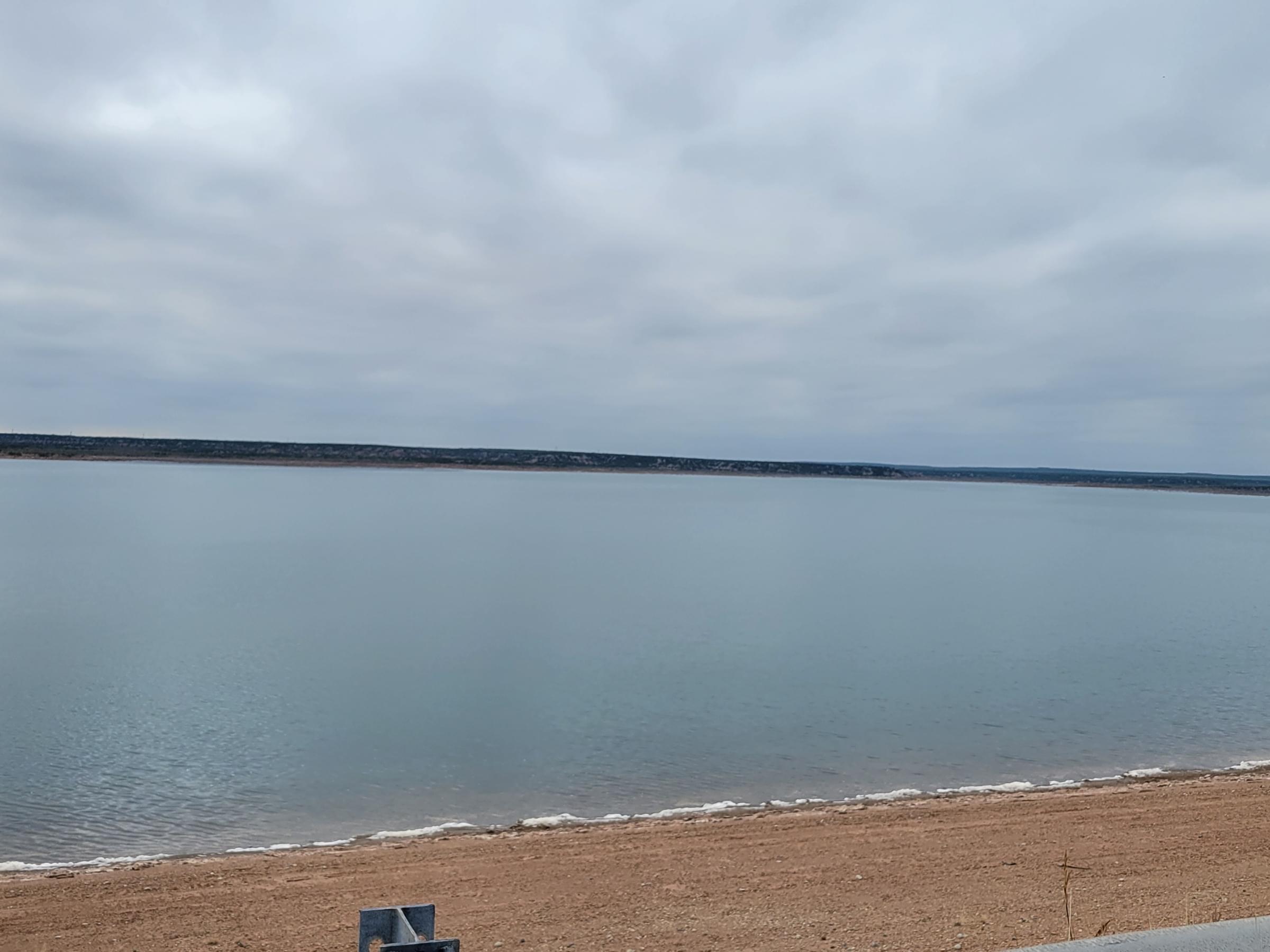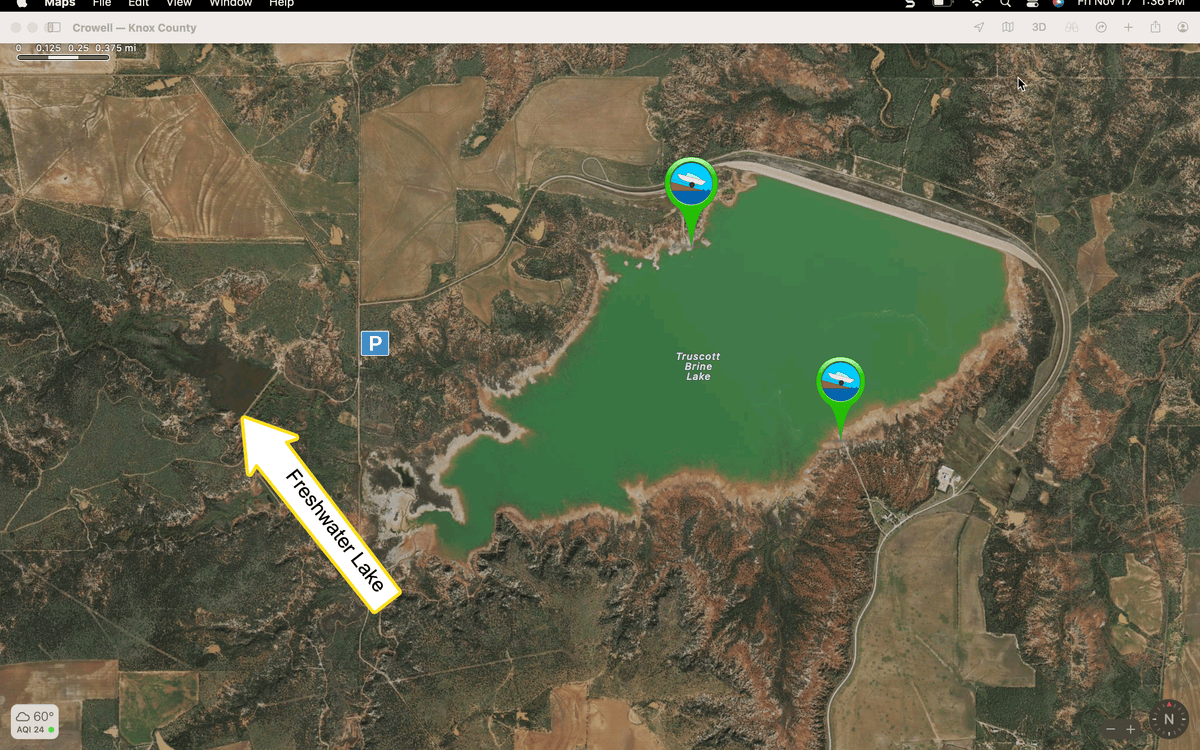Truscott (Brine) Lake

Truscott (Brine) Lake
13173 Co Rd 2631 Crowell, TX 79227 (Truscott, Texas 79227) Phone: 940-474-3293 Send us an e-mail!
Official WebsiteTips for Birding
Truscott Lake, which has an approximate salt level of an ocean, is a unique spot. There may not be another lake in North Central Texas with such a high salinity. Eared Grebes stay on the lake year-round and some months in great numbers (at times as high as 800, although this is not normal). It seems like a great spot to turn up something unusual.
The boat ramp is a good place to start viewing the lake. It might be possible to walk northeast along the shore, but only about 200 to 300 yards. Then drive over towards the dam and scope from that location. There is a road that comes off of the "dam" road on the west side of the lake. It winds down to another boat ramp on the west side of the lake that is another good vantage point.
Other good birds can be seen around the buildings and in the picnic area.
One other spot worth hitting (if it's not too hot) is on the west side of the lake. There is a freshwater tank (remember, Truscott itself is a saline lake). From the parking area, it is about a 0.75 mile walk or so. Be aware that there is waterfowl hunting, in season, especially on weekends.
Birds of Interest
A Knox County first of a Laughing Gull (and possibly two) was reported here in September 2023. Winter waterfowl include Snow, Greater White-fronted, Cackling and Canada Geese as well as the usual winter ducks (Blue-winged and Green-winged Teal, Northern Shoveler, Gadwall, American Wigeon, Mallard, Northern Pintail, Canvasback, Redhead, Ring-necked Duck, Lesser Scaup, Bufflehead, Common Goldeneye, Hooded Merganser, Ruddy Duck). Pied-billed and Horned Grebe are wintering grebes while Eared Grebes are abundant year-round. Greater Roadrunner appear year-round while Yellow-billed Cuckoo, Common Nighthawk and Snowy Plover are summer birds. Other shorebirds are generally fall to winter residents while Ring-billed Gull are present all winter. Great Egret, Great Blue Heron and Western Cattle Egret are breeding season birds. Summer sparrows include Cassin's, Grasshopper and Lark Sparrows with winter sparrows being predominantly White-crowned, Vesper, Savannah, Song and Lincoln's Sparrows. Blue Grosbeak, Painted Bunting and Dickcissel are present in the summer months.
About this Location
About Truscott Brine Lake
U.S. Army Corps of Engineers website about Truscott Lake
Many, many, many years ago – more than 25 million — the area that is now northwestern Texas, western Oklahoma, and southwestern Kansas was a large inland sea. The ocean is gone now, but the salt remains, and springs pump thousands of gallons of saltwater into the area’s rivers and streams. This natural brine pollution renders the Red River generally unsuitable as a dependable source of agricultural, municipal and industrial water supply.
The challenge of the Red River Chloride Control Project is to significantly reduce the salinity to make the area’s water usable. Tulsa District’s Truscott Project does just that for the south fork of the Wichita River. “Most people think we remove the salt from the water, but we don’t,” said Peat Robinson, natural resource conservation specialist. “We divert it.” That diversion is a fascinating process that begins more than 20 miles above Truscott Brine Lake at the Area VIII dam site and pump station.
There, an inflatable dam – basically a big rubber bladder – sits on a concrete weir that crosses the river. During dry times (and there are lots of those) when the river isn’t running, the dam is inflated to capture saltwater from the springs that flow into the river. The water will travel through a 22-mile pipeline that traverses the rugged and rocky West Texas terrain. The contained saltwater is first pumped at the rate of 3,000 gallons per minute seven miles to the highest elevation on the pipeline, peak surge.
From peak surge, gravity carries the water through two more segments to an evaporation spray field. There, the water is released from the pipeline through 40 spray nozzles. This spray process provides a higher evaporation rate than that which would occur if the water were just allowed to flow out of the pipeline. The evaporation field is often a field of rainbows; it’s an unusual, quite alluring sight with haunting sounds.
All the saltwater that doesn’t evaporate then makes its way into Truscott Brine Lake. The deep blue water of the lake has approximately the same salt content as an ocean. It’s even home to some saltwater fish.
Approximately 4,000,000 gallons of salt water per day is pumped into the lake. Truscott Lake is totally contained with no means of discharging water. The lake’s surface area is large enough that it evaporates as much water as is being pumped into the lake.
Back up at the dam site and pump station, when it has rained and the river is running, the dam is deflated; this allows the water with its greatly reduced salt content to flow over the dam and continue downstream.
Other pump stations, one on the Middle Fork of the Wichita River and one on the North Fork of the Wichita River are proposed as part of the Red River Chloride Control project but have yet to be built. When these two pump stations are constructed, the Wichita River portion of the Chloride Control project will be complete. This will control about 360 tons of chloride per day and will make the water in Lake Kemp usable 98% of the time.
Notable Trails
There really aren't any "trails" per se at this location.
The "wheelchair" accessible trail is the boat ramp area.
Features
Restrooms on site
Wheelchair accessible trail
Roadside viewing
Entrance fee
Content from Official Website
Last updated November 17, 2023
 Fresh water lake west of Truscott (Brine) Lake
Fresh water lake west of Truscott (Brine) Lake